
A description of the Bussey Bridge disaster comes (via Structure) from the engineer who drove the train. He testified that as he approached the bridge, “there was no appearance whatever of danger.” An engineer with 30 years of experience, he saw no signs that, within moments, dozens of people would be dead. “However, as I cast a glance at the train behind, I saw the first car swing inward and topple over as though about to fall, and while I still looked, amazed and bewildered, the second and third cars tipped over in similar positions, and all finally jumped the track.”
When inspectors from MIT were sent to the scene, they chalked the bridge collapse up to a few things: faulty materials, bad welding that had finally broken under the strain, a design that was destined to fail, and a complete lack of oversight. The investigation was also quick to point out that recommendations for upgrades had been made in 1881, then were completely disregarded.
Part of the problem wasn’t just down to the bridge’s construction, but also a strange part of the design that hid vital components that needed regular safety inspections. It was only once the bridge had collapsed — killing 23 people and injuring hundreds — that those hidden components were found to be wildly defective: The Boston Globe wrote, “Bad in contract, bad in make, bad in testing, and very bad in general.” Click here to read more about the most dangerous railways in the world.









